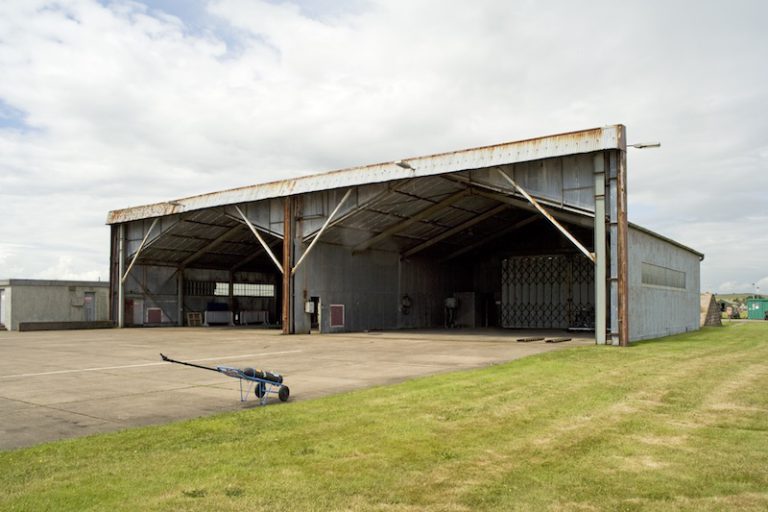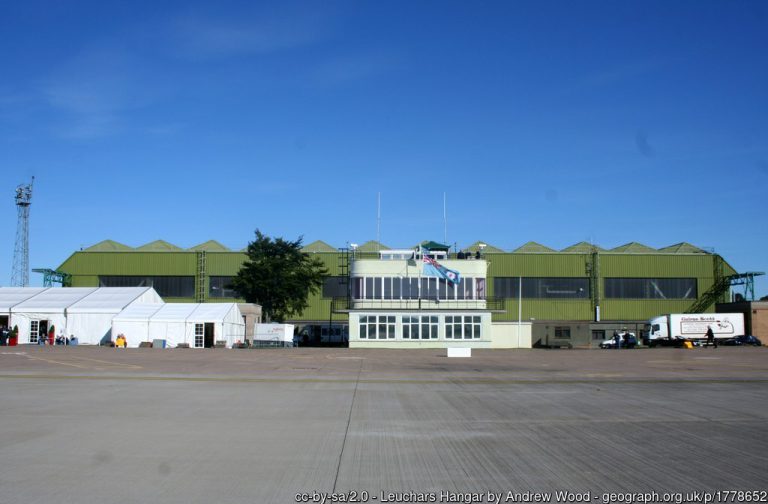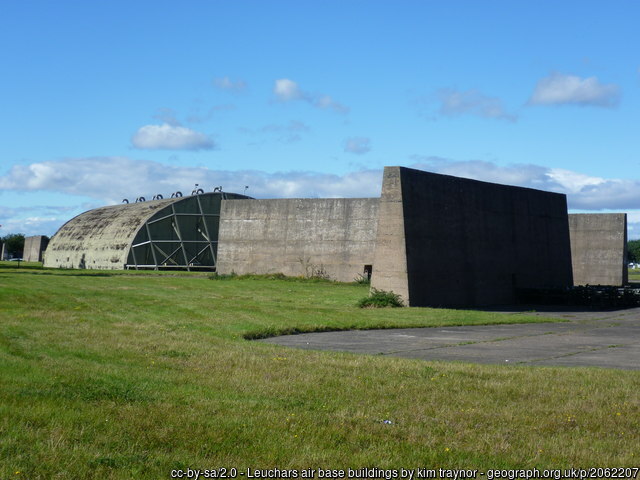Airfield search
Leuchars

| Also known as: | Leuchars Aerodrome / Leuchars Junction / Leuchars Station / RAF Leuchars / RAF Station, Leuchars |
| County: | Fife |
| Current Status: | Army barracks (main position) / Aviation |
| Date: | 1918 - 31 March 2015; subsequent limited use to present |
| Current Use: | Limited flying |
| Used By: | RAF / RAF (Dutch) / RAF (Norwegian) / FAA / Civil / RAAF / RCAF / RNZAF |
| Landing Surface Type(s): | Unpaved, later paved |
| Aircraft Role(s): | Fighter / Maritime patrol / Naval aviation / Trainer / Transport |
Leuchars, near St Andrews, has had a long and eventful military history. The first unit to arrive to spend any significant time at Leuchars was the Grand Fleet School of Aerial Fighting and Gunnery, which was at the site from the end of 1918 until 1920. At various times between 1920 and 1922 Nos 3, 203, and 205 Squadrons at what had now become RAF Base Leuchars operated aircraft such as Sopwith Camels, Parnall Panthers and Airco DH.9As. Subsequently, various Flights resided here while away from aircraft carriers as part of the Fleet Air Arm of the Royal Air Force.
Leuchars was one of the main RAF Training Bases through the inter-war period. No 1 Flying Training School later reformed at the airfield in the spring of 1935, training Fleet Air Arm pilots before moving to Netheravon in 1938. Armament training was also carried out between 1935 and 1939, using the range at Tentsmuir.
A major change occurred during 1938 as Leuchars passed to RAF Coastal Command control, with Avro Ansons of Nos 224 and 233 Squadrons moving in as the summer ended. By the time of Germany’s invasion of Norway anti-shipping patrols had become the primary task for these and various subsequent units, which often stayed for considerable periods of time. Notable among them mid-war were Handley Page Hampden elements, Nos 144 and 455 Squadrons. Other prominent aircraft types around this time included Bristol Blenheims, Beauforts and Beaufighters, as well as Lockheed Hudsons, while the de Havilland Mosquito landplane portion of Norwegian No 333 Squadron formed at Leuchars on 10 May 1943 prior to moving to Banff in September 1944. By the end of the Second World War several U-boats had been sunk by aircraft flying from Leuchars.
Leuchars always proved a versatile airfield, not least in wartime, by accommodating aircraft in widely differing roles. A long-term resident of the airfield moved to the site in the spring of 1940, the Communications Flight for No 18 Group, with a very wide variety of aircraft employed during and after the Second World War. The Flight remained at Leuchars, aside from briefly staying at Turnhouse into the 1960s. Photographic reconnaissance aircraft became most important residents during 1941-44, especially once No 540 Squadron formed with Mosquitoes in October 1942. No 3 Armament Practice Camp restarted armament training at Leuchars from November 1941, continuing to operate until the end of the war and eventual disbandment in September 1945.
Some of the most unusual missions to be carried out during the Second World War from Leuchars were by civilian Mosquitoes. Operated by BOAC, these aircraft transported important ball bearings and machine-tool steel from Stockholm through enemy airspace; passengers travelled within the bomb bays of the aircraft. The Americans mounted broadly similar and equally dangerous flights using Consolidated Liberators, complementing the more offensive maritime patrol RAF examples of Nos 206 and 547 Squadrons over the final year or so of fighting.
Varied forms of flying continued to take place after 1945, with the School of General Reconnaissance reforming at Leuchars in 1946, before disbanding in 1947. Operational Conversion Units used Leuchars at this time, training pilots on aircraft such as Supermarine Spitfires, de Havilland Mosquitoes and Vampires. No 120 Squadron maintained the maritime reconnaissance role with primarily Avro Lancasters until leaving for Kinloss as the decade ended.
Perhaps the role that Leuchars is most famous for began in the early 1950s as both day and night fighters moved in once the station switched to RAF Fighter Command control. No 151 Squadron’s Vampires were eventually replaced by Gloster Meteors, de Havilland Venoms and subsequently Gloster Javelins by the end of the 1950s as part of the squadron’s ten year residency. Another long serving unit was No 43 Squadron, initially operating Meteors, then followed by Hawker Hunters from 1954. The unit moved to Cyprus and then Aden during the early 1960s before disbanding, then reforming at Leuchars in 1969, flying McDonnell-Douglas F-4 Phantoms. More Javelins and English Electric Lightnings of Nos 11 and 23 Squadrons in turn appeared before the 1970s saw the arrival of No 111 Squadron, as well as the RAF Post Operational Conversion Unit (later known as the Phantom Training Flight) to train Fleet Air Arm aircrews. After many years, shore-based operational naval activity returned for a time too, between 1972 and 1978, when Phantoms of No 892 Squadron were not aboard HMS Ark Royal. During all this time Search and Rescue (SAR) helicopters also ensured that Leuchars continued to be firmly in the public eye, as did two University Air Squadrons to a lesser degree.
The RAF’s Phantoms were replaced by the Panavia Tornado F3 during the late 1980s, continuing to provide air defence cover for northern Britain and countering any possible Russian threat. These were replaced by the Eurofighter Typhoon, with No 6 and then No 1 Squadrons reforming at the start of the 2010s to operate the type as the Tornados were retired. The Typhoons however moved to Lossiemouth in 2014, taking with them the responsibility of the northern Quick Reaction Alert, with aircraft at Coningsby in Lincolnshire continuing to cover the south. Leuchars was transferred to the Army shortly afterwards and the majority of flying has since ceased, aside from limited use as an Emergency Landing Ground and for training. The two runways therefore remain in good condition, in addition to the hangars and support buildings. Two rare First World War Double Royal Flying Corps General Service Aircraft Sheds are among the buildings to survive almost the entirety of Leuchars’ military life. About the only aspect of aviation here which has tended to struggle has transpired to be civil aviation, as it has never gained a firm foothold over the years since the Second World War despite many local hopes, though civil and military aircraft use has as a general rule never easily mixed at Britain’s airfields.
The following organisations are either based at, use and/or have at least potentially significant connections with the airfield (as at 01/07/2013):
- Leuchars Community Council
- Leuchars HIVE
- Royal Scots Dragoon Guards Royal Armoured Corps
The following alternative information/mass media sources have at least potentially significant connections with the airfield (as at 31/12/2015):
- Leuchars Community Website
- The Newport, Wormit & Forgan Archive – photographs relating to Norwegian use during World War Two
Main unit(s) present:
-
No 1 FTS
-
No 1 PRU ‘C’ Flight
-
No 1 PRU Mosquito Flight
- No 1 Sqn
-
No 3 APC
- No 3 ATC
-
No 3 School of General Reconnaissance
-
No 3 Sqn
- No 6 Sqn
-
No 8 (Coastal) OTU
-
No 10 BAT Flight
-
No 11 Sqn
-
No 12 AEF
- No 14 Sqn
-
No 18 Gp Comm Flight
-
No 22 Sqn
-
No 23 Sqn
-
No 25 Sqn
- No 27 Sqn RAF Regiment
-
No 29 Sqn
-
No 42 Sqn
-
No 43 Sqn
-
No 72 Sqn
-
No 74 Sqn
-
No 82 Sqn
-
No 86 Sqn
-
No 105 Sqn
-
No 107 Sqn
- No 109 Sqn
-
No 111 Sqn
-
No 114 Sqn
-
No 120 Sqn
-
No 125 Expeditionary Air Wing (Fighter)
-
No 144 Sqn
-
No 151 Sqn
-
No 160 Sqn
-
No 202 Sqn
-
No 203 Sqn
-
No 205 Sqn
-
No 206 Sqn
-
No 217 Sqn
-
No 222 Sqn
-
No 224 Sqn
-
No 228 OCU
-
No 228 Sqn
-
No 229 OCU
-
No 233 Sqn
-
No 235 Sqn
- No 236 Sqn
-
No 237 OCU
- No 254 Sqn
-
No 264 Sqn
- No 275 Sqn
-
No 281 Sqn
-
No 320 Sqn
-
No 333 Sqn
-
No 401 (Fleet Fighter) Flight
-
No 402 (Fleet Fighter) Flight
-
No 403 (Fleet Fighter) Flight
-
No 404 (Fleet Fighter) Flight
- No 405 (Fleet Fighter) Flight
- No 406 (Fleet Fighter) Flight
-
No 415 Sqn
- No 421 (Fleet Spotter) Flight
-
No 441 (Fleet Reconnaissance) Flight
-
No 442 (Fleet Reconnaissance) Flight
-
No 443 (Fleet Reconnaissance) Flight
- No 443 (Fleet Spotter Reconnaissance) Flight
- No 443A (Fleet Reconnaissance) Flight
- No 444 (Fleet Reconnaissance) Flight
-
No 445 (Fleet Reconnaissance) Flight
- No 445 (Fleet Spotter Reconnaissance) Flight
-
No 446 (Fleet Reconnaissance) Flight
- No 446 (Fleet Spotter Reconnaissance) Flight
- No 447 (Fleet Spotter Reconnaissance) Flight
- No 449 (Fleet Spotter Reconnaissance) Flight
- No 450 (Fleet Spotter Reconnaissance) Flight
-
No 455 Sqn
- No 461 (Fleet Torpedo) Flight
- No 462 (Fleet Torpedo) Flight
-
No 489 Sqn
-
No 519 Sqn
-
No 540 Sqn
- No 541 Sqn
- No 542 Sqn
-
No 544 Sqn
-
No 547 Sqn
-
No 602 Sqn
-
No 603 Sqn
-
No 605 Sqn
-
No 607 Sqn
- No 612 Sqn
- No 612 Sqn RAuxAF
- No 745 Defence Sqn
-
No 800 Sqn
-
No 801 Sqn
-
No 802 Sqn
-
No 809 Sqn
-
No 810 Sqn
-
No 811 Sqn
-
No 814 Sqn
-
No 819 Sqn
-
No 822 Sqn
- No 846 Defence Sqn
-
No 892 Sqn
- No 1420 Flight
-
No 1477 (Norwegian) Flight
-
No 1510 BAT Flight
-
No 2745 Sqn RAF Regiment
- No 2846 Sqn RAF Regiment
- No 2860 Sqn RAF Regiment
- No 2954 Sqn RAF Regiment
-
Aberdeen, Dundee & St Andrews UAS
-
Aircraft Torpedo Development Unit
-
Autair
-
BOAC
-
Coast Defence Torpedo Bomber Flight
-
East Lowlands UAS
-
East of Scotland Universities Air Sqn
- Grand Fleet School of Aerial Fighting & Gunnery
-
Loganair
-
Phantom Conversion Flight
-
Phantom Training Flight
-
PRU
-
RAF Leuchars Flying Club
- RAF Base Leuchars
- RAF Post Operational Conversion Unit
- RAF Training Base Leuchars
- School of General Reconnaissance
- Scottish Sector
- St Andrews UAS
- St Andrews & Dundee Universities Air Sqn
- Station Flight, Leuchars
- Target Facilities Flight, Leuchars
- Temporary Armament Training Camp, Leuchars
- Temporary Armament Training Station, Leuchars
Luftwaffe vertical air photograph of Leuchars and part of the River Eden, 1940. © Courtesy of HES (Luftwaffe: Aerial Reconnaisance (Scotland)). Licensor canmore.org.uk
RAF aerial photograph of Leuchars. Visible are six camouflaged hangars built in the 1920s, part of the runways and four type 27 pillboxes. In the area to the south of the hangars are several different types of aircraft including Supermarine Spitfires, Handley Page Hampdens and Lockheed Lodestars, 25 September 1942. © Courtesy of HES (RAF Word War II Aerial Photographs). Licensor canmore.org.uk
RAF aerial photograph of the southern part of Leuchars. Visible is the camouflaged runways several 'Blister Hangars', pillbox and various airfield perimeter buildings with the River Eden, 25 September 1942. © Courtesy of HES (RAF Word War II Aerial Photographs). Licensor canmore.org.uk
An English Electric Lightning at Leuchars, August 1966.
A Panavia Tornado F3 in a hangar at Leuchars, 10 September 1990.
View of RAF Leuchars Domestic site, First World War barrack block building, now tailor's shop and launderette from the west, 29 September 2005. © Crown Copyright: HES. Licensor canmore.org.uk
View of First World War huts including former flight office from the south west at Leuchars, 4 October 2005. © Crown Copyright: HES. Licensor canmore.org.uk
The 1938 design control tower/watch office with meteorological section at Leuchars from south-east, 4 October 2005. © Crown Copyright: HES. Licensor canmore.org.uk
A Type C aircraft hangar at Leuchars from west, 4 October 2005. © Crown Copyright: HES. Licensor canmore.org.uk
Coupled General Service Shed showing doors and brick piers at Leuchars, 4 October 2005. © Crown Copyright: HES. Licensor canmore.org.uk
Interior of First World War hangar at Leuchars. Coupled General Service Shed showing the Belfast Truss roof tie-beams, knee-braces and gusset boards, 4 October 2005. © Crown Copyright: HES. Licensor canmore.org.uk
Dispersal site hardened bombproof aircraft shelter with aircraft fuel drop tanks in foreground at Leuchars, from the west, 5 October 2005. © Crown Copyright: HES. Licensor canmore.org.uk
Dispersal site at Leuchars showing Squadron gate guard, English Electric Lightning F3, and the rear of a hardened bombproof aircraft shelter from the east, 13 October 2005. © Crown Copyright: HES. Licensor canmore.org.uk
A plaque on one of the hangars at Leuchars, 29 October 2006.
View from the east of Q shed at Leuchars, 14 July 2009. © Crown Copyright: HES. Licensor canmore.org.uk
Fire Station and control tower at Leuchars, 12 September 2009.
A hangar and older control tower at Leuchars, 12 September 2009.
The older control tower at Leuchars, 12 September 2009.
Control tower at Leuchars, 11 September 2010.
Buildings at Leuchars, 11 September 2010.
Various civil aircraft at Leuchars, 1 August 2011.
Aerial view of the technical site at Leuchars, looking east-south-east, 1 July 2013. © Crown Copyright: HES. Licensor canmore.org.uk
Aerial view of Leuchars, looking east, 1 July 2013. © Crown Copyright: HES. Licensor canmore.org.uk
Eurofighter Typhoons lined up in front of hangars at Leuchars, 4 July 2013.
Eurofighter Typhoons on a runway at Leuchars, 17 July 2013.
Queen Elizabeth II presents a Squadron Standard to No 43 Squadron at Leuchars, 1957. Courtesy of British Pathé
Footage of English Electric Lightnings operating from Leuchars, 1965. Courtesy of British Pathé

Plan of Leuchars, 1918. Courtesy of Ed Andrews
| Decoy Airfield(s): | |
| Associated Airfield(s): |


























